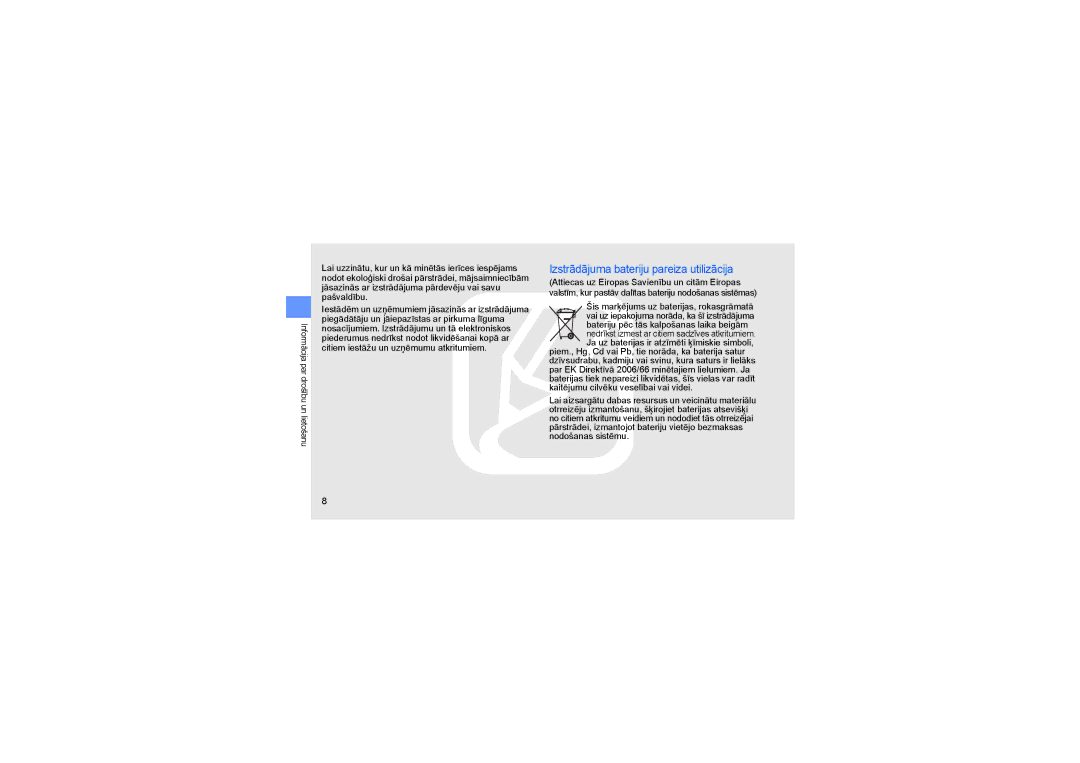Lietotāja rokasgrāmata
Piezīme piezīmes, lietošanas padomi vai papildinformācija
Norādījumu ikonas
Brīdinājums situācijas, kurās jūs vai citi var savainoties
Informācija par autortiesībām
Iii
Drošības brīdinājumi Drošības pasākumi
Komplektācija Tālruņa izkārtojums Taustiņi Displejs Ikonas
Pamatfunkciju lietošana
Pasaules pulksteņu izveide
Balss piezīmju ierakstīšana
Fotoattēlu un videoklipu augšupielāde
Drošības brīdinājumi
Dzirdes aizsardzība
Piesardzība mobilo tālruņu un piederumu uzstādīšanā
Drošības pasākumi
Sargājiet akumulatorus un lādētājus no bojājumiem
Rīkojieties ar tālruni uzmanīgi un pareizi
Tālruņa remontu drīkst veikt tikai kvalificēti speciālisti
Svarīga lietošanas informācija
Lietojiet tālruni normālā stāvoklī
Saudzīgi lietojiet SIM kartes un atmiņas kartes
Nodrošiniet piekļuvi avārijas dienestu pakalpojumiem
Izstrādājuma pareiza likvidēšana
Izstrādājuma bateriju pareiza utilizācija
Atruna
HONORĀRIEM, Izdevumiem VAI Citiem
Iepazīšanās ar mobilo tālruni
Komplektācija
Tālruņa izkārtojums
Tālruņa displejā ir šādi apgabali
Taustiņi
Displejs
Ikonas
Iepazīstiet displejā redzamās ikonas
Ikona Apraksts
Mobilā tālruņa salikšana un sagatavošana darbam
SIM kartes un akumulatora ievietošana
Ievietojiet akumulatoru Uzlieciet akumulatora pārsegu
Akumulatora uzlāde
Zema akumulatora uzlādes līmeņa indikators
Atmiņas kartes ievietošana papildiespēja
Pārslēdzoties uz bezsaistes profilu, varat lietot
Tālruņa ieslēgšana un izslēgšana
Pārslēgšanās uz bezsaistes profilu
Skārienekrāna lietošana
Savā skārienekrānā jūs varat veikt tālāk redzamās darbības
Logrīku joslas atvēršana
Piekļūšana izvēlnēm
Logrīku izmantošana
Logrīku pievienošana gaidīšanas režīma ekrānam
Taustiņu toņu skaļuma pielāgošana
Piekļuve palīdzības informācijai
Tālruņa pielāgošana
Vibrācijas intensitātes pielāgošana skārienekrānā
Fona attēla izvēle gaidīšanas režīmā
Galveno zvanīšanas funkciju lietošana
Zvana signāla maiņa
Tālruņa bloķēšana
Skaļuma regulēšana
Zvana veikšana
Atbildēšana uz zvanu
Skaļruņa funkcijas lietošana
Īsziņas vai multiziņas sūtīšana
Ziņu sūtīšana un apskatīšana
Austiņu lietošana
Pasta ziņas sūtīšana
Teksta ievades režīma maiņa
Teksta ievade
Ievadiet ziņas tekstu un nospiediet Gatavs
Ciparu
Pasta ziņas apskate
Kontaktu pievienošana un meklēšana
Īsziņu vai multiziņu apskate
Jauna kontakta pievienošana
Fotoattēlu apskatīšana
Galveno kameras funkciju lietošana
Fotoattēlu uzņemšana
Rediģēt
Videoklipu apskatīšana
Mūzikas klausīšanās
Videoklipu uzņemšana
FM radio klausīšanās
Izvēlnes režīmā atlasiet Mūzika → Mūzikas atskaņotājs
Mūzikas failu klausīšanās
FM radio vadība, izmantojot šādas ikonas
Izvēlieties mūzikas kategoriju → norādiet mūzikas failu
Lai regulētu atskaņošanu, izmantojiet šādus taustiņus
Tīmekļa pārlūkošana
Tīmekļa lapu pārlūkošana
Atkarībā no pakalpojumu sniedzēja
Grāmatzīmju veidošana biežāk apmeklētajām tīmekļa lapām
Pārvietojieties pa tīmekļa lapām, izmantojot šādas ikonas
Pēdējā zvanītā numura izsaukšana
Papildu zvanīšanas funkciju lietošana
Neatbildēto zvanu apskatīšana un atzvanīšana
Uzziniet par sava tālruņa papildu zvanīšanas iespējām
Atbildēšana uz otru zvanu
Zvana aizturēšana vai aizturētas sarunas atjaunošana
Otra zvana veikšana
Konferences zvana veikšana konferences zvans
Zvanīšana kontaktam no tālruņu kataloga
Tālruņa kataloga papildu funkciju lietošana
Starptautiska numura sastādīšana
Vizītkartes izveidošana
Teksta veidnes izveidošana
Papildu ziņojumapmaiņas funkciju lietošana
Kontaktu grupas izveidošana
Izvēlieties Izveidot grupu
Ziņas izveidošana, izmantojot multivides veidni
Multivides veidnes izveidošana
Teksta veidņu ievietošana jaunās ziņās
Mapes izveidošana ziņu pārvaldīšanai
Panorāmas fotoattēlu uzņemšana
Kameras papildfunkciju izmantošana
Fotoattēlu sēriju uzņemšana
Fotoattēlu uzņemšana ar dekoratīviem ierāmējumiem
Fotografēšana režīmā Smaidošs uzņēmums
Dalīto fotoattēlu uzņemšana
Izvēlieties → Nospiediet kameras taustiņu
Atlasīt → , lai piekļūtu turpmāk norādītajiem iestatījumiem
Kameras iespēju izmantošana
Kameras iestatījumu pielāgošana
Mūzikas failu kopēšana atmiņas kartē
Papildu mūzikas funkciju lietošana
Mūzikas failu kopēšana, izmantojot Samsung PC Studio
Tālruņa sinhronizācija ar programmu Windows Media Player
Izvēlieties Pievienot → Ieraksti
Atskaņošanas saraksta izveide
Mūzikas atskaņotāja iestatījumu pielāgošana
Izvēlieties failus, kas jāpievieno, un nospiediet Pievienot
Pievienojiet austiņas tālruņa universālajai kontaktligzdai
Radiostaciju automātiskā saglabāšana
Mūzikas informācijas meklēšana
Izvēlnes režīmā atlasiet Mūzika → Atrast mūziku
Izvēlnes režīmā atlasiet Programmas → Bluetooth
Bezvadu funkcijas Bluetooth lietošana
Bezvadu funkcijas Bluetooth ieslēgšana
Datu saņemšana, izmantojot Bluetooth bezvadu funkciju
Bluetooth ierīču meklēšana un savienošana pārī
Datu sūtīšana, izmantojot bezvadu funkciju Bluetooth
Atlasiet Sūtīt, izmantojot vai Sūtīt URL pa → Bluetooth
SOS ziņu aktivizēšana un sūtīšana
Balss ierakstīšana
Mobilā meklētāja aktivizēšana
Neīsto zvanu veikšana
Ievadiet paroli un nospiediet Apstipr
Balss piezīmes ierakstīšana
Balss piezīmju ierakstīšana un atskaņošana
Neīsta zvana veikšana
Balss piezīmes atskaņošana
Attēla pielāgošana
Attēlu rediģēšana
Attēlu efektu lietošana
Iemācieties rediģēt attēlus un lietot uzjautrinošus efektus
Vizuālas funkcijas ievietošana
Attēla pārveidošana
Attēla apgriešana
Izvēlieties Rediģēt → Apgriezt
Piezīmes pievienošana rokrakstā
Attēlu drukāšana
Fotoattēlu un videoklipu augšupielāde tīmeklī
Biežāk lietoto adresātu saraksta iestatīšana
Faila augšupielāde
Spēļu spēlēšana
Java spēļu un programmu izmantošana
Spēļu vai programmu lejupielāde
Programmu palaišana
Datu sinhronizēšana
RSS lasītāja izmantošana
Pasaules pulksteņa izveide
Pasaules pulksteņu izveide un apskatīšana
Pasaules pulksteņa skats
Izvēlnes režīmā atlasiet Plānotājs → Pasaules pulkstenis
Jauna signāla iestatīšana
Signālu iestatīšana un izmantošana
Kalkulatora lietošana
Signāla pārtraukšana
Hronometra lietošana
Valūtu un mērvienību konvertēšana
Atpakaļskaitīšanas taimera iestatīšana
Jauna uzdevuma izveide
Kalendāra skata mainīšana
Teksta piezīmes izveide
Kalendāra pārvaldīšana
Notikuma izveide
Problēmu novēršana
Lai piekļūtu
Numurs pēc ievadīšanas netiek izsaukts
Tālrunis pīkst, un mirgo akumulatora ikona
Ierakstīšana
Uzlāde Zema uzlādes līmeņa indikators
Attālais SIM režīms, 47 datu saņemšana, 47 datu sūtīšana
Sk. tālruņa bloķēšana
Sk. rīki, kalkulators
Sk. rīki, hronometrs
Sk. rīki, kalendārs
Sk. zvani, konference
Taustiņu toņu skaļums, 23 zvana skaļums
Izveide Pārtraukšana
Profila izveidošana, 56 sākšana
Sk. rīki, atpakaļskaitīšanas taimeris
Vienkāršā uzņemšana
Skatīt zvani, viltus zvanu veikšana
GSM mobilais tālrunis GT-S5230
Atbilstības deklarācija R&TTE
Latvian /2009. Rev

